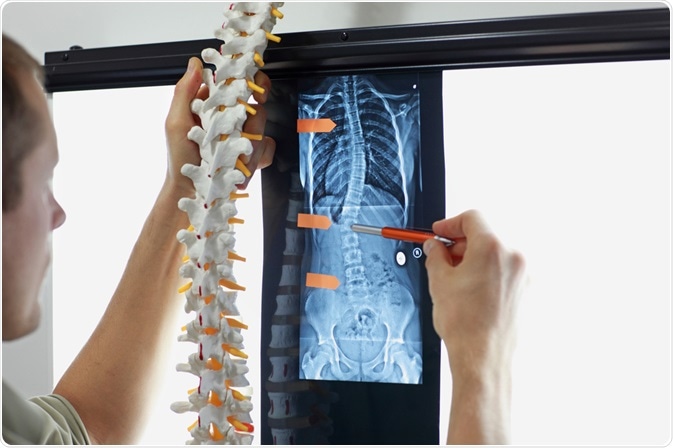The prognosis of scoliosis can vary immensely according to the degree of the spinal deformity. Upon the initial diagnosis during childhood, it is difficult to predict the future growth of the spine as the child grows; therefore, the expected deformity cannot be known with certainty.
However, there are some indicative factors that can help to speculate the prognosis of the condition for the individual. Thoracic spine anomalies and multiple fully segmented hemivertebrae have a tendency to progress more.

Image Credit: Marcin Balcerzak / Shutterstock.com
The majority of the spinal growth occurs in the first five years of life and in the adolescent growth spurt just before puberty. These two time periods, therefore, are the most critical times and the spinal growth of children with scoliosis in these age groups should be monitored closely. If interventions are made to promote healthy spinal growth and reduce curvature, the prognosis is usually improved.
Mild scoliosis
A curve of fewer than 20 degrees can be described as mild scoliosis. The prognosis for this condition is positive and most individuals with the form of the condition do not require any specific treatment.
Instead, these patients should be monitored for signs of worsening of the condition, particularly as children grow, to prevent the degree from increasing.
Moderate scoliosis
A curve between 25 and 70 degrees can be described as moderate scoliosis. Current research has not drawn strong conclusions about the outcomes or resulting health complications of this group of individuals with the condition.
For this reason, the utility of surgical intervention is not clear and recommendations are currently made on a case-by-case basis.
Severe scoliosis
A curve greater than 70 degrees can be described as severe scoliosis. This often causes the ribs to press against the lungs, leading to a restriction of breathing and thus lead to hypoxia. The reduced levels of oxygen in the blood can have implications on the function of other organs in the body. Additionally, the spinal curvature may cause structural changes in the heart with dangerous outcomes.
Intervention to promote healthy spinal growth is routinely recommended for individuals with severe scoliosis.
Very severe scoliosis
A curve greater than 100 degrees can be described as very severe scoliosis. This commonly leads to repercussions for both the heart and the lungs due to the changes in the structural space in the chest. Individuals with this very severe form of scoliosis are more susceptible to lung infections and pneumonia.
This level of deformity is rare in developed countries but is associated with significantly increased mortality rates in respect to other severities.
Lifelong health
Medical studies have shown that, for individuals with scoliosis, the overall physical and mental health over their lifetime is comparable to the general population.
Even without treatment, most patients with scoliosis are able to lead functional and productive lives, with nine out of ten patients displaying normal cardio and pulmonary function.
It is worth noting that some experts have voiced concern over using the measurement of the spinal curvature as the sole point of reference to identify patients at risk of cardiopulmonary complications. They argue that other factors should also be considered, including spinal flexibility and the asymmetry of the ribs and vertebrae.
References
Further Reading